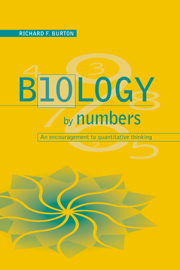Book contents
- Frontmatter
- Contents
- Preface
- A guide to the book
- 1 Putting two and two together
- 2 Units, formulae and the use of old envelopes: confronting some obstacles to quantitative thinking
- 3 Aspects of energy metabolism
- 4 Getting things in proportion
- 5 Perilous percentages, dangerous ratios
- 6 Building a trophic pyramid
- 7 Sodium in animals and plants
- 8 Exchanges of water and carbon dioxide
- 9 A geometric series
- 10 Introduction to logarithms
- 11 Bringing logarithms to life
- 12 Exponential relationships
- 13 Aspects of allometry
- 14 More on allometry, and on quantitative patterns in nature
- 15 How the abundance of food affects rates of feeding
- 16 The characterization of trees and other branching systems
- 17 Epilogue
- References
- Notes
- Index
9 - A geometric series
Published online by Cambridge University Press: 05 June 2012
- Frontmatter
- Contents
- Preface
- A guide to the book
- 1 Putting two and two together
- 2 Units, formulae and the use of old envelopes: confronting some obstacles to quantitative thinking
- 3 Aspects of energy metabolism
- 4 Getting things in proportion
- 5 Perilous percentages, dangerous ratios
- 6 Building a trophic pyramid
- 7 Sodium in animals and plants
- 8 Exchanges of water and carbon dioxide
- 9 A geometric series
- 10 Introduction to logarithms
- 11 Bringing logarithms to life
- 12 Exponential relationships
- 13 Aspects of allometry
- 14 More on allometry, and on quantitative patterns in nature
- 15 How the abundance of food affects rates of feeding
- 16 The characterization of trees and other branching systems
- 17 Epilogue
- References
- Notes
- Index
Summary
Double, double …
William ShakespeareThe theme now is the geometric series 1, 2, 4, 8, 16, etc. in which each number is obtained by doubling the previous one. The individual topics will seem somewhat diverse, although several have loosely to do with breeding. However, the overall purpose is prepare the way for logarithms and exponentials in later chapters.
As to biological relevance, imagine a single bacterium that divides into two. These two divide into four, and those into eight – and so on until after n divisions, if all survive, there are 2n bacteria. Alternatively, imagine an idealized seaweed that grows by dichotomous branching, growing from an unbranched frond by repeated bifurcations. I say ‘idealized’ because in practice the growth of a such a plant tends to be uneven (Figure 9.1), with the branches getting out of step with each other, and with some ceasing to divide altogether. A similar sort of dichotomous branching occurs during the development of the mammalian lungs, albeit with some irregularity there too: the trachea branches into the two largest bronchi; these then bifurcate successively to produce smaller bronchi and then bronchioles (Thurlbeck & Wang, 1974; Burton, 1994).
More approximate arithmetic
Before considering further applications of the series, let me illustrate a point made earlier about biological arithmetic. You will not find it hard to calculate in your head a few more numbers in that sequence: 16, 32, 64 and so on.
- Type
- Chapter
- Information
- Biology by NumbersAn Encouragement to Quantitative Thinking, pp. 100 - 107Publisher: Cambridge University PressPrint publication year: 1998



